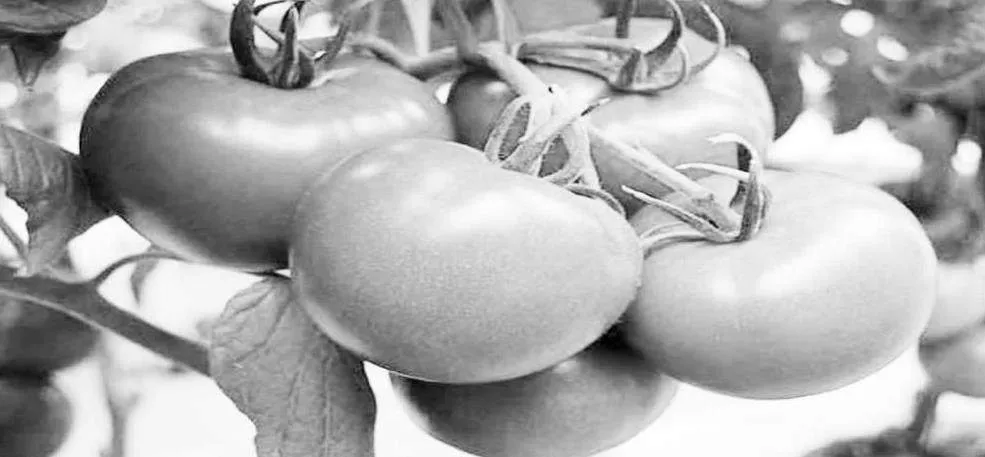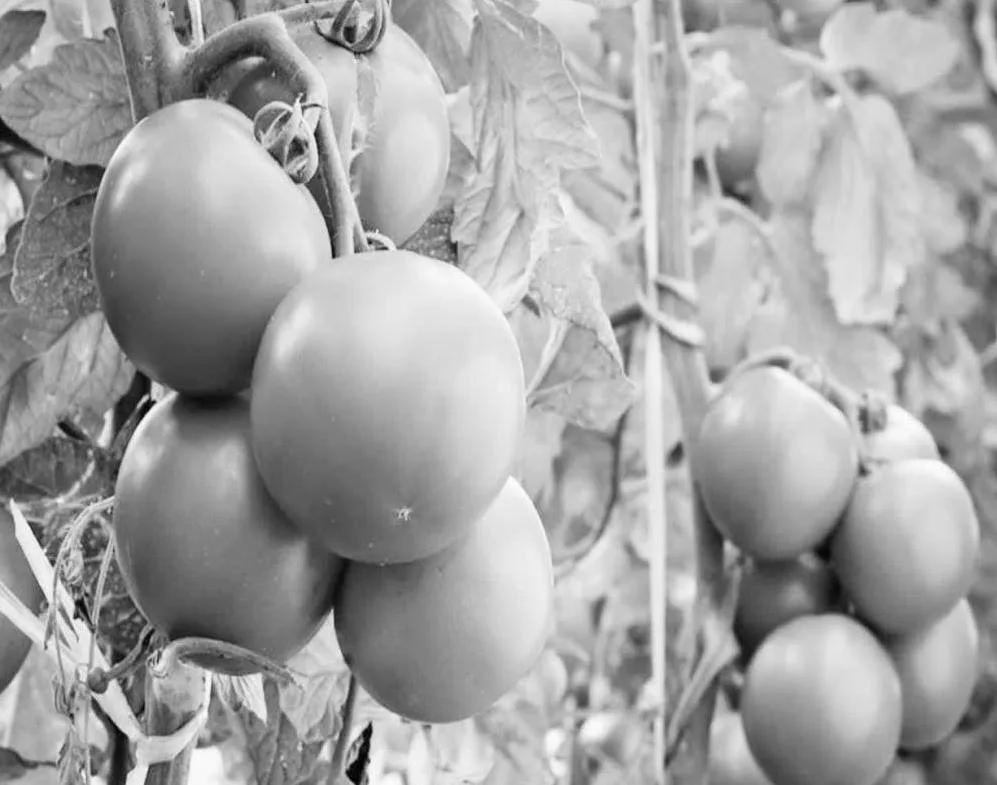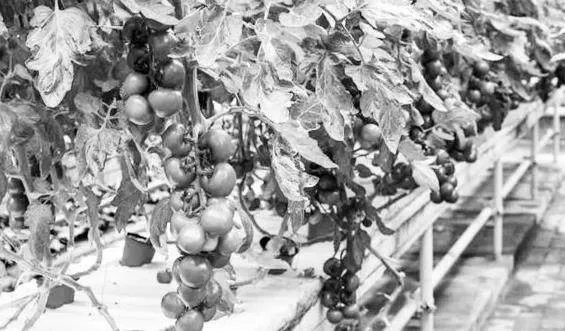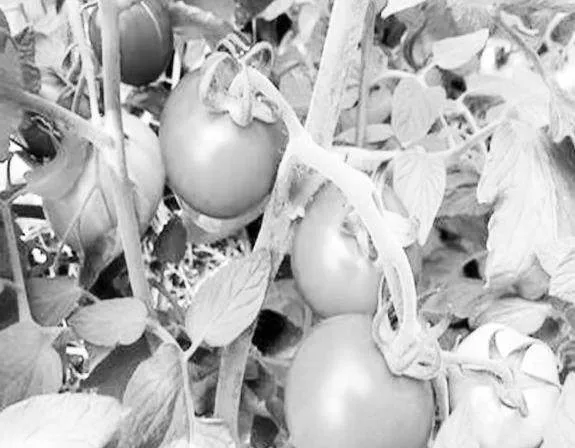




摘要:[目的]为探讨加工番茄果实番茄红素与相关性状之间的关系,为新疆加工番茄优质新品种选育提供理论依据。[方法]以近年来选育或引进的品种(系)为试验材料,对供试加工番茄果实番茄红素与可溶性固形物含量、平均果肉厚度、pH、a/b值、β-胡萝卜素及L值这些品质性状之间的相关性,并进行逐步回归分析和通径分析。[结果]结果表明,新疆加工番茄品种(系)的7个果实的可溶性固形物含量、平均果肉厚度、pH、a/b值、β-胡萝卜素及L值进行相关性分析,在7个果实品质性状中,pH与L值成显著正相关,番茄红素与a/b值成极显著正相关,与L值成极显著负相关,与β-胡萝卜素成负相关,但相关性不显著。a/b值与番茄红素成极显著正相关,与β-胡萝卜素和L值成极显著负相关。β- 胡萝卜素与L值成极显著正相关,与X5成极显著负相关,与番茄红素成负相关,但相关性不显著。L值与β-胡萝卜素成极显著正相关,与pH成显著正相关,与番茄红素和a/b值成极显著负相关。主成分分析结果表明,前3个主成分的贡献率达83.721%,可以反应所测性状的绝大部分变异信息。第一成分因子的贡献率为45.728%,第二主成分因子和第三主成分因子的贡献率分别为18.443%和16.793%。[结论]"加工番茄育种中,需选择可溶性固形物和番茄红素含量较高的性状组合,以获得高产优质的品种。
关键词:北疆; 加工番茄; 果实; 番茄红素; 品质性状; 关系
Study on the relationship between Lycopene and main quality characters of processing tomato in northern Xinjiang
TianHaiyan1,2,Zhang Zhanqin1,2, XIE Jianhui1,2,WANG Jianjiang1,Yang Xiangkun1,2
(1.Crop Research Institue,Xinjiang Academy of Agricultural and Reclamation Science,Shihezi,Xinjiang 832000;2.Key Lab of Xinjiang Production and Construction Crops for Cereal Quality Research and Genetic Improvement,Shihezi,Xinjiang 832000)
Abstract:[objective] To explore the relationship between lycopene and related traits of processing tomato fruit, and to provide theoretical basis for processing tomato breeding in Xinjiang. [methods ] The varieties (lines) selected or introduced in recent years were used as experimental materials, the correlation between lycopene content and soluble solid content, mean pulp thickness, pH, a B value, Beta-carotene and L value was studied, stepwise regression analysis and path analysis were performed. [results]"The results showed that the contents of soluble solids, average flesh thickness, pH, a B value, Beta-carotene and L value of 7 fruits of Xinjiang processing tomato varieties (lines) were correlated, there was a significant positive correlation between pH and L value, a significant positive correlation between lycopene and a B value, a significant negative correlation between lycopene and L value, a significant negative correlation between lycopene and L value, a significant positive correlation between lycopene and L value, a significant negative correlation between lycopene and L value, a significant positive correlation between lycopene and L value, a significant positive correlation between lycopene and L value, a significant positive correlation between lycopene and L value, a significant negative correlation between lycopene and But the correlation was not significant. There was a significant positive correlation between a B value and lycopene, and a significant negative correlation between a B value and beta-carotene and L value. The beta-carotene was positively correlated with L, negatively correlated with x 5 and negatively correlated with lycopene, but the correlation was not significant. L value was significantly positively correlated with beta-carotene, positively correlated with pH, and negatively correlated with lycopene and aab. The results of principal component analysis showed that the contribution rate of the first three principal components was 83.721% , which could reflect most of the variation information of the tested traits. The contribution rate of the first factor was 45.728% , the second and third principal factors were 18.443% and 16.793% , respectively. [conclusion] In processing tomato breeding, the combination of high content of soluble solids and lycopene should be selected to obtain high yield and good quality varieties.
Key Words:"Northern Xinjiang;processing tomato;ruit;lycopene;quality traits;relationship
0 引言
番茄是一种重要的蔬菜和水果,具有适应范围广、产量高、营养丰富、用途广泛等多方面的优点,既可生食代替水果,又可加工制成各种产品,具有广阔的市场前景。对于加工番茄品种而言,可溶性固形物和番茄红素的含量,是决定一个品种取舍的关键[1]。番茄红素具有极强的抗氧化性,在延缓衰老和对某些癌症的预防方面具有特殊功效。人体自身不具有合成番茄红素的能力,主要通过饮食来摄取。番茄果实中富含番茄红素,因而受到人们的普遍喜爱。因此,培育高番茄红素含量的品种对于人们对番茄红素的需求有着重要意义[2-3]。目前关于番茄各性状之间的相关关系已有不少的研究和报道[3-7],然而针对北疆加工番茄果实番茄红素的研究相对较少,本文特针对30个新疆北疆加工番茄品种(系)的果实番茄红素与主要品质性状之间的关系进行研究,以期筛选出与番茄红素相关的易于进行早期筛选的农艺性状,为培育高番茄红素加工番茄品种提供依据。
1 材料与方法
1.1 "试验地概况
试验于2021年在新疆石河子市新疆农垦科学院育种试验基地进行,该地区属于典型的干旱气候区,年平均气温7.5 ~ 8.2℃,日照2 318 ~ 2 732 h,无霜期147 ~ 191 d,年降雨量180 ~ 270 mm,年蒸发量1 000 ~ 1 500 mm,≥10℃活动积温357 0 ~ 3 729℃。试验地土质为粘壤土。
1.2 "供试材料
选用30个新疆当地主栽加工番茄品种(系)作为供试材料,其中包括美国亨氏公司的H9661、H5108、H1015、 H3402;法国利马格兰公司的ALT2、 ALT3 、ALT5、 ALT9、AST900、AST908;美国联合基因公司的UG9417,国产品种:金番3166、中蔬3370、屯河1601、屯河6619、KF1502;其余为新疆农垦科学院作物所加工番茄育种创新团队自育新品系。
1.3 "试验设计
试验于2021年在新疆农垦科学院作物所试验站内开展,人工移栽,采用膜下滴灌种植方式,一膜两行,株距33 cm,行距配置25 cm + 125 cm。
1.4 "测定项目与方法
每个小区取加工番茄中上部30个果实,从中随机选择5个充分成熟的果实,每个果从中间连续纵切2次,各取1/4混匀后打成果浆,取出3份(各20 mL)分别测得番茄红素和L、a、b的数值。用MASTER-3M(日本爱宕品牌)手持折射仪测定可溶性固形物含量。田间收获时从植株中上部选取3 ~ 5个充分成熟果实,横切后将番茄汁倒入仪器进行读数。pH采用美国SpectrumIQ150 测定。果肉厚度测量方法是从中央部位将果实横切,使用数显游标卡尺测量。
番茄果实L、a、b值及番茄红素应用意大利玛萨莉(MASELLI)色差仪(LC01)测定,其中:L值反映番茄颜色的明亮程度:0"~ 100表示从黑色到白色;“a”代表物体的红绿色:正值表示红色,负值表示绿色;“b”代表黄蓝色:正值表示黄色,负值表示蓝色,"a/b为色差值,值越大,颜色越红。可溶性固形物含量的高低是衡量加工番茄品质的重要指标之一,在番茄酱的制造过程中可溶性固形物含量也起到关键作用。研究表明,可溶性固形物每增加l%就相当于增加25%的总产量,相当于成品番茄酱(浓度为28%)的产量提高了15%~20%[8]。
1.5 "数据统计分析
利用EXCEL2003和SPSS17.0软件进行数据处理与分析。
2 "结果与分析
2.1 "供试加工番茄品种(系)主要品质性状的变异
对30个新疆加工番茄品种(系)7个品质性状的变异情况进行分析,由表1可以看出,在加工番茄7个品质性状中变异范围大小存在差异,其中,番茄红素和L值的变异范围较大,分别在13.1 ~ 26.2,29.2 ~ 40.2;a/b值和平均果肉厚度的变异范围较小,在2.0 ~ 2.7,0.5 ~ 0.8。从变异系数的大小来看,β-胡萝卜素、番茄红素及平均果肉厚度变异系数相对较大,分别达30.0%、番茄红素14.5%及14.3%,说明上述性状变异程度较为丰富,可为不同品质育种需求提供相应的种质资源。
2.2""主要性状间的相关性分析
将30个新疆加工番茄品种(系)的7个果实品质指标(可溶性固形物含量、平均果肉厚度、番茄红素、pH、a/b值、β- 胡萝卜素及L值)进行相关性分析。通过表1可以看出,在7个果实品质性状中,pH与L值成显著正相关,番茄红素与a/b值成极显著正相关,与L值成极显著负相关,与β-胡萝卜素成负相关,但相关性不显著。a/b值与番茄红素成极显著正相关,与β-胡萝卜素和L值成极显著负相关。β-胡萝卜素与L值成极显著正相关,与X5成极显著负相关,与番茄红素成负相关,但相关性不显著。L值与β-胡萝卜素成极显著正相关,与PH成显著正相关,与番茄红素和a/b值成极显著负相关。
2.3 "番茄红素的逐步回归和通径分析
番茄红素是加工番茄主要的品质性状指标,为分析对番茄红素有正向影响和负向影响的直接因子和间接因子,对番茄红素与其它性状进行逐步线性回归分析,可得出以下番茄红素回归方程:番茄红素回归方程:Y = -66.547 - 0.370 x1,- 1.231x2,"- 0.884x3,"+ 29.334x5,"+ 6.048x6,"+ 0.505x7,
在上述回归方程中:Y为番茄红素,X1,为平均可溶性固形物含量(%)、X2,为平均果肉厚度(cm)、X3,为PH、、X5,为a/b值、X6,为β- 胡萝卜素、X7,为L值。R2 = 0.824,方程拟合度较好,此模型可以用于加工番茄果实番茄红素的预测。
进一步进行通径分析可以看出(表3),加工番茄6个品质性状对果实番茄红素的直接影响作用中,a/b值对番茄红素含量的影响最大,其次是β- 胡萝卜素,平均可溶性固形物含量、平均果肉厚度、pH对番茄红素含量有负面影响作用,其中,pH对番茄红素含量的负面影响作用相对较大。
从6个品质性状对番茄红素的间接通径效应(表4)大小可以看出,"X5通过X2对番茄红素的作用效果明显较大,说明增加a/b值与平均果肉厚度形成间接影响番茄红素的直接原因,也是其它因素对番茄红素发生作用的间接原因。X2、X3、X6主要通过X7间接影响番茄红素含量。X5和X7主要通过X6间接影响番茄红素含量。因此,在加工番茄品质育种中可通过调节β-胡萝卜素和L值调节对番茄红素含量的影响效应。
2.4 "主要性状的主成分分析
对7个主要性状进行主成分分析,特征值、贡献率、累积贡献率及特征向量见表5。由表5可知,前3个主成分的贡献率达83.721%,可以反应所测性状的绝大部分变异信息。
第一成分因子特征值为2.744,其贡献率为45.728%,以β-胡萝卜素和L值的特征向量的分值较高;第二主成分因子特征值为1.107,其贡献率为18.443%,以平均可溶性固形物含量和L值的分值较高;第三主成分因子特征值为1.008,其贡献率为16.793%,以平均果肉厚度和L值的分值较高。
3 "讨论
番茄红素含量的高低是衡量番茄品种和番茄制品优劣的重要指标之一[9]。番茄果实内的番茄红素含量遗传属多基因控制的数量性状遗传,一代杂种果实内番茄红素的含量居双亲之间,接近于中亲值,遗传模型以加性效应为主,有少量上位效应,显性效应不显著,该性状以一般配合力效应为主,特殊效应配合力不大。采用杂交育种的选育方法,有利于获得高番茄红素品种的选育。庞胜群、曲瑞芳等[10-11]在提高番茄红素含量的选育过程中,也应注重干物质、可溶性固形物、总酸、总糖含量的选择,通过育种、栽培等手段提高这些农艺性状的水平可增加番茄红素含量。
本文相关和通径分析结果表明,新疆加工番茄品种(系)的7个果实的可溶性固形物含量、平均果肉厚度、pH、a/b值、β-胡萝卜素及L值进行相关性分析,在7个果实品质性状中,pH与L值成显著正相关,番茄红素与a/b值成极显著正相关,与L值成极显著负相关,与β-胡萝卜素成负相关,但相关性不显著。a/b值与番茄红素成极显著正相关,与β-胡萝卜素和L值成极显著负相关。β-胡萝卜素与L值成极显著正相关,与X5成极显著负相关,与番茄红素成负相关,但相关性不显著。L值与β-胡萝卜素成极显著正相关,与pH成显著正相关,与番茄红素和a/b值成极显著负相关。
主成分分析结果表明,前3个主成分的贡献率达83.721%,可以反映所测性状的绝大部分变异信息。第一成分因子的贡献率为45.728%,第二主成分因子和第三主成分因子的贡献率分别为18.443%和16.793%。本试验结果表明,加工番茄育种中可通过a/b值、L值来调节果实番茄红素含量。
4 "结论
加工番茄品质受外界自然条件、水肥调控和栽培密度的影响,育种目标是在高产的同时提高固形物和番茄红素含量。番茄红素属数量性状,受微效多基因支配,在提高番茄红素含量的育种中,须结合番茄育种其他目标性状,综合进行选育达到育种目标[12]。
本试验在前人研究结果的基础上, 对加工番茄品种(系)的7个果实的可溶性固形物含量、平均果肉厚度、pH、a/b值、β-胡萝卜素及L值进行相关性分析,表明加工番茄育种中也可通过a/b值、L值来调节果实番茄红素含量。
参考文献(References)
[1]王海延,王鸣,李长年,等.番茄育种[M].上海科学技术出版社,1998:5.
Wang Haiyan,Wang Ming, Li Changnian, etc. . Tomato breeding [m] . Shanghai Scientific and Technical Publishers, 1998:5.
[2"]王岩,周义军.番茄红素的研究进展[J].国外医学卫生分册,2000,27(4):11.
Wang Yan, Zhou Yijun. Research progress of Lycopene [J]. Foreign Medical and health pamphlet, 2000, 27(4): 11.
[3]李君明,徐和金,周永建.有关番茄果实中可溶性固形物和番茄红素的研究进展 [J].园艺学报,2001,28(增刊):661-668 .
Li Junming, Xu and Jin, Zhou Yongjian. Research progress on soluble solids and lycopene in tomato fruit[J]. Journal of Horticulture, 2001,28(supplement): 661-668.
[4]关法春,李景富,许向阳,等.加工番茄粘稠度与其他农艺性状的相关与通径分析[J].中 国蔬菜,2007(3):15-17.
Guan Fachun, Li Jingfu, Xu Xiangyang, etc. . Correlation and path analysis of viscosity and other agronomic traits in processing tomato [J] . Chinese vegetables,2007(3): 15-17.
[5]王华新,秦勇,王雷.加工番茄主要品质性状的遗传变异分析[J].北方园艺,2004(2):525.
Wang Huaxin, Qin Yong, Wang Lei. Genetic variation analysis of main quality traits in processing tomato [J] . Northern Horticulture,2004(2): 525.
[6]王雷,王鸣,石英,等.加工番茄主要数量性状遗传相关的研究[J].西北农业学报,1998,"7(1):32-37.
Wang Lei, Wang Ming, quartz, etc. . Studies on genetic correlation of main quantitative traits in processing tomato[J]. Journal of Northwest Agriculture, 1998, 7(1): 32 -37.
[7]郑建超.番茄主要农艺性状与产量相关及通径分析[J].吉林农业科学,1999,24(3):48-51.
Zheng Jianchao. Correlation and path analysis between main agronomic traits and yield of tomato [J] . Jilin agricultural sciences,1999,24(3):48 -51.
[8】赵怀勇,李群,张红菊.加工番茄可溶性固形物含量相关因素研究[J].北方园艺,2007,3(2):22—24.
Zhao Huaiyong, Lie group,Zhang Hongju. Study on the relative factors of soluble solid content in processing tomato [J] . Northern Horticulture, 2007,3(2): 22-24.
[9]叶兴干.番茄贮藏保鲜与加工[M].北京:农业版社,1992.
Ye Xing-qian. Preservation and processing of tomatoes [m] . Beijing: Agricultural Press,1992.
[10]庞胜群,郑群,辛建华,等.加工番茄农艺性状与番茄红素的灰色关联分析[J].北方园艺 2010(4):12-14.
Pang Shengqun,Zheng Qun, Xin Jianhua, etc. . Grey correlation analysis of agronomic traits and lycopene in processing tomato [J] . Northern Horticulture 2010(4): 12-14.
[11]曲瑞芳.番茄果实中番茄红素的遗传分析及与农艺性状的相关性研究[J].杨凌:西北农林科技大学,2006.
Qu Ruifang. Genetic analysis of lycopene in tomato fruit and its correlation with agronomic traits[J] . Yang Ling: Northwest Aamp;F University, 2006.
[12]李相梅,许向阳,张贺,等.番茄果实中番茄红素含量与主要数量性状相关性及通径分析[J].东北农业大学学报,2011,42(10):62-65.
Li Xiangmei,Xu Xiangyang, Zhang He, etc. . Correlation and path analysis between lycopene content and main quantitative traits in tomato fruit [J] . Journal of Northeast Agricultural University,2011,42(10):62 -65.
Study on the relationship between Lycopene and main quality characters of processing tomato
TIAN Haiyan,ZHANG Zhanqin, XIE Jianhui,WANG Jianjiang,YANG Xiangkun
(Crop Research Institue,Xinjiang Academy of Agricultural and Reclamation Science / Key Lab of Xinjiang Production and Construction Crops for Cereal Quality Research and Genetic Improvement,Shihezi Xinjiang 832000, China)
Abstract:【Objective】 To explore the relationship between lycopene and related traits of processing tomato fruit, and to provide theoretical basis for processing tomato breeding in Xinjiang.
【Methods】 The varieties (lines) selected or introduced in recent years were used as 30 experimental materials, the correlation between lycopene content and soluble solid content, mean pulp thickness, pH value, a/b value, beta-carotene and L value was studied, and meanwhile, stepwise regression analysis and path analysis were performed.
【Results】 The results showed that the contents of soluble solids, average flesh thickness, pH value, a/b value, Beta-carotene and L value of 7 fruits of Xinjiang processing tomato varieties (lines) were correlated, there was a significant positive correlation between pH value and L value, a significant positive correlation between lycopene and a/b value, a significant negative correlation between lycopene and L value, a significant negative correlation between lycopene and L value, a significant positive correlation between lycopene and L value, a significant negative correlation between lycopene and L value, a significant positive correlation between lycopene and L value, a significant positive correlation between lycopene and L value, a significant positive correlation between lycopene and L value, a significant negative correlation between lycopene, but the correlation was not significant. There was a significant positive correlation between a/b value and lycopene, and a significant negative correlation between a/b value and beta-carotene and L value. The beta-carotene was positively correlated with L value, negatively correlated with X5 and negatively correlated with lycopene, but the correlation was not significant. L value was significantly positively correlated with beta-carotene, positively correlated with pH value, and negatively correlated with lycopene and aab. The contribution rate of the first three principal components was 83.721% , which could reflect most of the variation information of the tested traits. The contribution rate of the first factor was 45.728% , the second and third principal factors were 18.443% and 16.793%, respectively.
【Conclusion】 In processing tomato breeding, the combination of high content of soluble solids and lycopene should be selected in order to obtain high yield and good quality varieties.
Key words:processing tomato; fruit; lycopene; quality traits
Fund projects:Construction of a Public Service Platform for Processing Tomato Quality Testing in the Key Laboratory of Grain Quality and Genetic Improvement of XPCC (23102001); Second Cycle Second Level Training Candidate Funding Project for \"XPCC Talents\" (21102009); "Funding Project of Soybean and Characteristic Cash Crop Breeding Innovation Team of Xinjiang Academy of Agri-Reclamation Sciences (2060502)
Correspondence author:YANG Xiangkun(1981-),male,from Shandong,research,Ph.D., research direction:Breeding and cultivation of processed tomatoes,(E-mail)starryyang@sina.com
第一作者简介:田海燕(1979-),女,硕士,副研究员,现主要从事加工番茄育种与栽培等研究工作。E-mail:1114077556@qq.com。
责任作者:杨相昆(1981-),男,博士,研究员,现主要从事加工番茄育种与栽培等研究工作。E-mail:starryyang@sina.com。
基金项目:谷物品质与遗传改良兵团重点实验室加工番茄品质测试公共服务平台建设(23102001)。“兵团英才”第二周期第二层次培养人选资助项目(21102009)。新疆农垦科学院大豆与特色经济作物育种创新团队资助项目(2060502);





